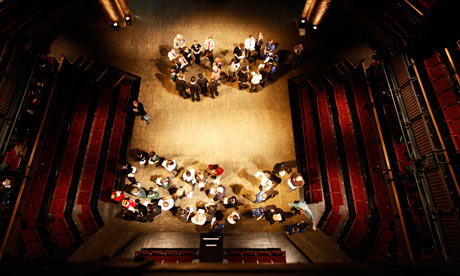The most common type of theater spacial configuration is proscenium, in which the audience has the opportunity to view the play as a whole and obtain the most visual and audial entertainment. The distance between the performers and the audience in a proscenium theater is vastly greater than the distance of a thrust configuration; this allows for greater scenic depth and detail but limits the intimate relationship that is possible with the thrust stage. Lastly, the arena form of spacial configuration offers its own unique aspect of theater where physical performance is emphasized over anything else. In a sense, the advantages of a certain form of spacial configuration are the disadvantages of another form and vice versa.
For example, the picture below is the completed renovation of the Royal Shakespeare Company theater that is located in the hometown of legendary playwright William Shakespeare. A link to the article and picture suggests that audience members were becoming weary of the inaudible voices from the performers. Although a proscenium offers a much more scenic view that contributes to grander scale of theater, a thrust such as the one below can allow for deeper interaction between the audience and performance. A similar affect can be achieved from an in the round arena.
An aerial view of a thrust stage at the Royal Shakespeare Theater in Stratford-upon-Avon

No comments:
Post a Comment